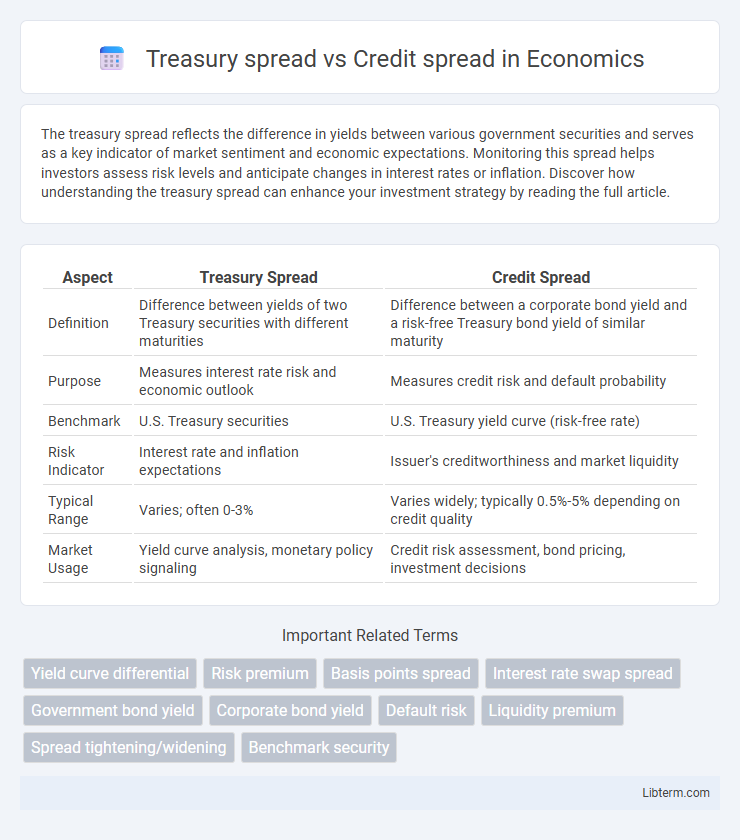The treasury spread reflects the difference in yields between various government securities and serves as a key indicator of market sentiment and economic expectations. Monitoring this spread helps investors assess risk levels and anticipate changes in interest rates or inflation. Discover how understanding the treasury spread can enhance your investment strategy by reading the full article.
Table of Comparison
| Aspect | Treasury Spread | Credit Spread |
|---|---|---|
| Definition | Difference between yields of two Treasury securities with different maturities | Difference between a corporate bond yield and a risk-free Treasury bond yield of similar maturity |
| Purpose | Measures interest rate risk and economic outlook | Measures credit risk and default probability |
| Benchmark | U.S. Treasury securities | U.S. Treasury yield curve (risk-free rate) |
| Risk Indicator | Interest rate and inflation expectations | Issuer's creditworthiness and market liquidity |
| Typical Range | Varies; often 0-3% | Varies widely; typically 0.5%-5% depending on credit quality |
| Market Usage | Yield curve analysis, monetary policy signaling | Credit risk assessment, bond pricing, investment decisions |
Introduction to Treasury Spread and Credit Spread
Treasury spread refers to the difference in yields between U.S. Treasury securities of different maturities, primarily measuring interest rate risk and market liquidity conditions. Credit spread represents the yield difference between corporate bonds and comparable maturity Treasury bonds, reflecting the risk premium investors demand for bearing credit risk. Both spreads serve as critical indicators for assessing economic health, with Treasury spread often linked to economic cycles and credit spread signaling corporate creditworthiness.
Definition of Treasury Spread
Treasury spread refers to the difference in yield between two U.S. Treasury securities of varying maturities, commonly measured as the spread between long-term and short-term Treasury bonds. This spread reflects investors' expectations about future interest rates, economic growth, and inflation. In contrast, credit spread represents the yield difference between a corporate bond and a comparable-maturity Treasury bond, accounting for credit risk.
Definition of Credit Spread
Credit spread refers to the yield difference between a corporate bond and a risk-free government bond of similar maturity, reflecting the additional risk premium investors require for credit risk. Treasury spread typically measures the yield gap between two maturities of U.S. Treasury securities, highlighting interest rate risk and liquidity factors. Understanding credit spread is essential for assessing default risk and the compensation demanded by investors for bearing credit-related uncertainties.
Key Differences Between Treasury and Credit Spreads
Treasury spreads reflect the yield difference between various U.S. Treasury securities, indicating risk-free interest rate expectations and monetary policy outlook, while credit spreads measure the yield difference between corporate bonds and comparable Treasury securities, reflecting credit risk and issuer default probability. Key differences include that Treasury spreads primarily signal macroeconomic conditions and liquidity in government debt markets, whereas credit spreads provide insights into the credit quality of corporate issuers and market sentiment toward corporate debt risk. Treasury spreads tend to be narrower and more stable due to their sovereign backing, whereas credit spreads are wider and more volatile, influenced by company-specific factors and overall economic stress.
Factors Influencing Treasury Spreads
Treasury spreads are primarily influenced by factors such as Federal Reserve monetary policy, inflation expectations, and overall economic conditions impacting government bond yields. Market liquidity and demand for safe-haven assets also play critical roles in determining Treasury spreads. Changes in these elements cause fluctuations in the yield differences between short-term and long-term Treasury securities, reflecting investor sentiment and risk appetite.
Drivers Behind Credit Spreads
Credit spread represents the yield difference between corporate bonds and risk-free Treasury securities, primarily driven by factors such as issuer credit risk, macroeconomic conditions, and market liquidity. Key drivers behind credit spreads include default risk, economic growth expectations, and changes in interest rates or monetary policy that influence investor risk appetite. Treasury spreads mainly reflect government bond yield curves, whereas credit spreads incorporate additional premiums for creditworthiness and compensates investors for bearing default risk.
Economic Implications of Treasury vs Credit Spreads
Treasury spreads reflect the difference between yields on government securities and benchmark rates, serving as indicators of overall economic risk and monetary policy impact. Credit spreads measure the yield premium investors demand for corporate bonds over Treasuries, directly signaling perceived credit risk and the health of corporate balance sheets. Sharp widening of credit spreads often precedes economic downturns, while narrowing suggests improved credit conditions and investor confidence in the economy.
Market Signals Derived from Spreads
Treasury spreads, measuring the yield difference between various U.S. Treasury securities, signal shifts in risk-free interest rates and investor expectations about economic growth and inflation. Credit spreads, reflecting the yield premium of corporate bonds over Treasuries, indicate the market's perception of credit risk and borrower default probabilities. Widening Treasury spreads often suggest increased economic uncertainty or expectations of Fed policy shifts, while widening credit spreads typically forecast deteriorating corporate credit conditions or potential economic downturns.
Investment Strategies Leveraging Spreads
Investment strategies leveraging Treasury spreads focus on the difference between yields of U.S. Treasury securities of varying maturities, capitalizing on expectations of interest rate movements and economic cycles. Credit spread strategies exploit the yield differential between corporate bonds and risk-free Treasuries, reflecting credit risk and economic conditions to identify mispriced securities. Portfolio managers use these spreads to enhance returns and manage risk by adjusting exposure to interest rate changes and credit quality fluctuations.
Conclusion: Treasury Spread vs Credit Spread
Treasury spread measures the difference between yields on two U.S. Treasury securities of varying maturities, reflecting interest rate risk and liquidity preferences, while credit spread represents the yield difference between corporate bonds and comparable-maturity Treasuries, indicating credit risk. The Treasury spread is primarily influenced by macroeconomic factors and monetary policy, whereas credit spread directly correlates with the issuer's creditworthiness and default risk. Investors should analyze both spreads together to gauge overall market conditions, as widening credit spreads signal increased default risk while changes in Treasury spreads highlight shifts in interest rate expectations.
Treasury spread Infographic

 libterm.com
libterm.com